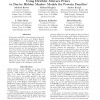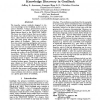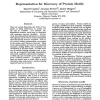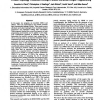ISMB
1993
14 years 25 days ago
1993
This paper presents results from an ongoing effort in applying a variety of induction-based methods to the problem of predicting the biological activity of noncongeneric (structu...
ISMB
1993
14 years 25 days ago
1993
A Bayesian method for estimating the amino acid distributions in the states of a hidden Markov model (HMM) for a protein familyor the columns of a multiple alignment of that famil...
ISMB
1993
14 years 25 days ago
1993
Algorithmsbasedonprobability theorycanaddressissues of uncertainty directly throughtheir representational frameworkandtheir theoryfor data combination.In this paper, wediscuss the...
ISMB
1993
14 years 25 days ago
1993
Wedescribe various methods designed to discover knowledge in the GenBanknucleic acid sequence database. Using a grammatical model of gene structure, we create a parse tree of a ge...
ISMB
1993
14 years 25 days ago
1993
There are several dimensions and levels of complexity in which information on protein motifs may be available. For example, onedimensional sequence motifs may be associated with s...
ISMB
1993
14 years 25 days ago
1993
Thoughit has been possible in the past to learn to predict DNAhydration patterns from crystallographic data, there is ambiguity in the choice of training data (both in terms of th...
ISMB
1993
14 years 25 days ago
1993
ISMB
1994
14 years 25 days ago
1994
A new version of the GRAIL system (Uberbacher and Mural, 1991; Mural et al., 1992; Uberbacher et al., 1993), called GRAILII, has recently been developed (Xu et al., 1994). GRAILII...
ISMB
1994
14 years 25 days ago
1994
Weconsider the problem of parsing a sequence into different classes of subsequences.Twocommonexamplesare finding the exons and introns in genomicsequences and identifying the seco...
ISMB
1994
14 years 25 days ago
1994
Wepresent the prototype of a software system, cMledGeneQuiz,for large-scale biological sequence analysis. The system was designed to meet the needs that arise in computational seq...




